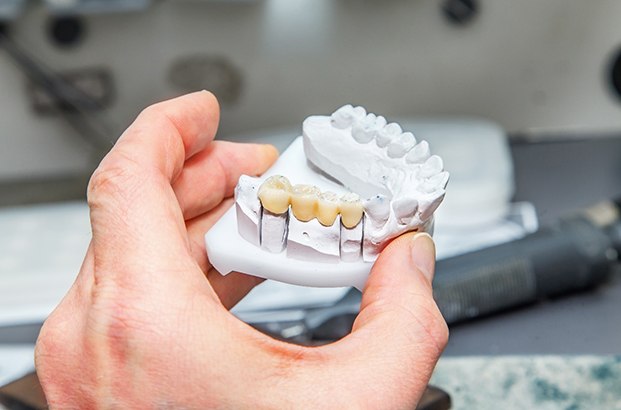Dental Bridges – East Longmeadow, MA
Seamlessly Replace the Gaps in Your Smile
Did you know that an estimated 140 million people are missing at least one tooth? If you’re a part of that statistic, you know from experience just how much extensive tooth loss can affect your quality of life. Luckily, you don’t have to live with a smile you don’t love. At EMA Dental, we offer a high-quality tooth-replacement solution known as dental bridges. Not only do they allow you to regain complete function of your full set of teeth, but you can enjoy a beautiful, natural-looking appearance. If you’d like to learn more about dental bridges in East Longmeadow, continue reading or schedule a consultation with our team today!
Why Choose EMA Dental for Dental Bridges?
- Advanced Technology Used to Make Quality Restorations
- Natural-Looking Replacement Teeth
- Insurance-Friendly Dental Practice
What is a Dental Bridge?

A dental bridge is a prosthetic that closes (or “bridges) the spaces in your smile. It’s comprised of two dental crowns located on either side of the replacement teeth, called pontics. The crowns are anchored to your remaining teeth on either side of the gap. The prosthetic is custom-crafted from natural-looking materials, such as ceramic and porcelain. Since they’re color-matched to your tooth enamel, no one will even be able to tell that you have a restoration once they’re in place! To be eligible for a dental bridge, you must have excellent oral and overall health, strong teeth free of decay, and one to four missing consecutive teeth.
Types of Dental Bridges

During your consultation, our team will conduct an oral examination to determine whether or not you’re an ideal candidate for this tooth-replacement solution. We’ll ask about your smile goals and review your medical and oral health history to decide which option works best for your needs. After our discussion, we’ll recommend one of the following types of dental bridges:
Traditional Bridge

Do you have one or more missing teeth that are right next to each other? A traditional dental bridge may be the right option for you. It’s anchored to your mouth with dental crowns, seamlessly closing the gaps in your smile. Keep in mind that your natural teeth will need to be altered to replace the missing ones.
Implant Bridge

For more stability, we offer implant bridges, which are secured to your mouth using two dental implants instead of crowns. The titanium posts are placed on either side of the space in your smile. Once they’ve fused with the surrounding bone tissue via a process called osseointegration, we’ll attach a dental bridge to the implants to replace the missing teeth. The best part? This option requires no alteration of your surrounding teeth!
The Benefits of Dental Bridges

When you replace your missing teeth with dental bridges in East Longmeadow, you can expect to reap a range of benefits, including:
- Maintained alignment of your existing teeth
- Improved oral health
- Jawbone preservation with implant bridges
- A long-lasting restoration that can last up to 15 years (traditional) or over 35 years (implant-retained)
- Natural-looking results that blend seamlessly with your existing teeth
- Lower maintenance and easy to care for
Are you ready to start your journey towards a fully restored smile? Contact our office and schedule a consultation today!
Dental Bridges FAQs

Patients have trusted dental bridges in Longmeadow and Northampton for generations to treat tooth loss , but they are a big commitment. It’s normal to have a few concerns before you are comfortable agreeing to the procedure. There isn’t any reason to worry. Here are the answers to some frequently asked questions to ease any apprehensions.
Can I take out a dental bridge?
A dental bridge differs from a partial because it isn’t removable. A partial denture uses clips or clasps to stay in place, so you can take it out at any time. A bridge is different because it’s designed to stay in your mouth for several years. Traditionally, crowns are bonded over the adjacent teeth to hold the bridge in place; however, dental implants can also anchor it to your jawbone. Therefore, only a qualified dentist in East Longmeadow and Northampton can remove your bridge.
How many teeth can I replace with a bridge?
A bridge can treat 1 to 4 consecutive lost teeth, but longer restorations may not have the same support. It can place additional strain on the abutment teeth, especially if they aren’t strong or healthy. Often, a traditional bridge is recommended for 1 to 2 teeth, while an implant-retained solution can treat more without the added risks. Dental implants are surgically placed into the jawbone to anchor your bridge in place for unmatched stability.
Are dental bridges covered under insurance?
Every dental insurance policy is unique, but most plans can be used to offset the amount you’ll pay out-of-pocket. Many insurances consider bridges a major service, so they may pay about 50% of the cost, but some plans may cover more. After meeting your deductible, you can use your annual allowance to complete your smile for reduced rates. We will work on your behalf with your dental insurance to maximize your yearly benefits to reduce the amount you’ll pay. Our office offers various financial solutions for any remaining balance, like third-party financing.
How long will a dental bridge last?
The average traditional bridge will last for about 5 to 15 years before needing to be replaced, but various factors affect their lifespans, like the materials used. Metal restorations can last a little longer than ceramic bridges; however, they aren’t very attractive. You can ensure your bridge thrives for years by following a solid home oral hygiene routine. You should also visit your dentist every 6 months for a cleaning and checkup. Besides keeping your mouth clean and healthy, avoid any habits that may damage your new smile, like grinding your teeth, chewing on your fingernails, or smoking. The location of your bridge can also affect its life expectancy. Teeth in the back of the mouth undergo more wear and tear, so they may have a minimally shorter lifespan. If you’re interested in a more permanent solution, an implant bridge may be the better option. Dental implants should never need replacing with the proper maintenance to save money down the road.
How Do I Clean Under My Dental Bridge?
Aside from brushing it directly, you’ll also need to clean beneath your dental bridge. That said, the process of doing so isn’t as tricky as you’d think.
There are several good ways to clean the area under a dental bridge. One approach is to loop traditional floss through a threader, then slide the pointed end beneath your device and out the other end. Another is to use an interdental or interproximal brush, which contains puffy bristles attached to a wire. You could even rely on water flossers like a Waterpik, as their streams of water can aim underneath your prosthetic.
Which Foods Should You Avoid with Dental Bridges?
Dental bridges can’t handle all foods well, so you should avoid certain kinds to ensure your treatment results last. Otherwise, you'll have to spend time and money on replacement dental work.
In particular, please steer clear of sticky items. Foods like fruit gummies, caramel, and soft candies can cling to a dental bridge’s surface, exposing your mouth to harmful substances for prolonged periods. Worse, they can loosen your prosthetic or even pull it right off your teeth.
You should also go easy on sugary stuff, which can decay your abutments. That means limiting your intake of sweets and only having them in moderation. If you don’t, the teeth supporting your dental bridge could decay and force your restorations to fall out.
Can Dental Bridges Be Whitened?
Sadly, dental bridges can’t be whitened like natural teeth can. Their design prevents them from changing color via treatment.
It comes down to how modern teeth whitening works. To brighten your smile, the procedure applies bleaching gel that enters your enamel through pores and breaks apart stains. Dental bridges don’t have such pores themselves, so whitening gel can’t get inside them to treat discoloration.
All that said, there are workarounds to this issue. You can always get your teeth whitened before you have a bridge placed, ensuring no part of your smile stands out.
Do Dental Bridges Feel Natural?
When placed properly, dental bridges feel natural within a few days of treatment. Your own should seem like a “normal” part of your smile very quickly.
For one thing, today’s dental bridges are made from highly durable materials. They can thus withstand everyday chewing forces just as well as your natural teeth do. Indeed, eating with your bridge shouldn’t feel strange to you at all.
Note also that your dental bridge is tailored to your smile. The device is designed based on dental impressions, and the dentist reshapes your abutments to ensure a good fit. Such customization prevents your bridge from feeling noticeable in your day-to-day life.
